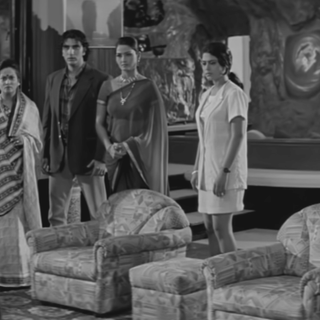
Bollywood Needs Heroes Who Don’t Self‑Destruct When They’re in Love
Stereotypical portrayals of men’s distress promote real, violent consequences for women.

In Raanjhana (2013), Kundan cuts himself after Zoya rejects him, leading Zoya to immediately regret her past choice and embrace him. In Devdas (2002), Paro’s rejection leads Devdas to alcoholism, and the film ends with him dying at her doorstep. In Kabir Singh (2019), the titular lead angrily overdoses on morphine because his soon-to-be-married object of desire doesn’t come to meet him on time.
Rejection from women in Hindi cinema often leads to the man becoming a manipulative, emotionally distressed mess.
Male romantic leads in these films thrash within the trope of a passionate, self-destructive man, almost immobilized by the heady love they feel for the woman. Their distress manifests as various mental health issues — from suicide attempts and self-harm to substance abuse. The problem is, intertwining poor mental health with romantic passion leads to the normalization of self-destructive behaviors and extreme expressions of love in real life. This further stigmatizes mental illnesses as a temporary affliction that can be snapped out of if the person simply gets what they want — in this case, their love interest.
In the November 2020 issue of the medical journal The Lancet Psychiatry, Sohini Chattopadhyay writes, “Mental health among men has rarely been a focus of popular Hindi film. We see, instead, heroes suffering the ravages of failed love: as such, their dysfunction is seen as grief and not as depression.” But, despite the unpredictable, complex nature of emotional distress and mental illness, Hindi cinema’s distressed heroes have ‘simple’ and ‘understandable’ reasons for their descent into madness — love and rejection. Rather than treating extreme reactions to rejection as symptomatic of a greater problem, cinema shows us that it’s rejection that causes extreme reactions. This places the sole responsibility of a man’s grief and mental distress at women’s feet and further reinforces the sexist notion that women are wholly responsible for the way people react to them.
Further, made possible by both mainstream cinema’s inevitable effect on real life and the hero-worship of Hindi film actors, people emulating these lead characters’ passionate, self-destructive behaviors in real life could do grave harm. Manipulative, self-destructive love in films turn into copy-cat actions that are criminal in the real world. In 2016, a stalker who said he was influenced by the film Darr elaborately stalked and later kidnapped a young woman. In 2019, a man who said he was influenced by Kabir Singh gunned down a woman he loved because she decided to marry someone else.
Related on The Swaddle:
Such representation of male mental distress in Hindi cinema is linked to upholding masculine self-reliance and virtue — a man could never lose his mind unless it is for love. In Dilwale (1994), a cop refuses to take up a case involving a character in an asylum, fearing he would himself go “mad.” However, the cop is moved to reconsider when he finds out that the character’s madness was caused by an unfortunate break-up with a girlfriend. He agrees to take up the case after this because only the insertion of ‘love’ could have humanized the ‘insane’ character for him.
If we examine the differences between male and female insanity in Hindi cinema, men are often the beneficiaries of such ‘humanizing’ perspectives. Films that depict mental illnesses in women like Woh Lamhe, Fashion, and Heroine do not cast the women’s self-destruction in an attractive, ‘relatable’ light. This difference in who we see as lovably self-destructive is a perception problem that has its roots in Victorian psychiatry. Back then, doctors believed that men possessed specific motives (such as bogus insurance claims, desire to avoid work) to self-harm, whereas women were “motiveless malingerers” or hysterical, as “hysterical patients are extremely fond of attracting attention and sympathy.” This research, by Sarah Chaney, Ph.D., from the Queen Mary University of London, also states that women’s hysteria was viewed as occurring due to reproductive problems or excessive emotions. Considering the heavy stigma surrounding mental illness in men, it’s clear why complex depictions of male distress will not receive the sort of favorable reception that lovelorn, rejected heroes in (temporary) frail states do.
And so, the heartbroken man in Hindi film self-destructs as a manipulative tactic to attract attention and sympathy. In Raanjhana, Kabir Singh, and Devdas, heroes use self-destruction as a means to beget attention from the women they love. But, the perverse morality of ‘doing it for love’ paints manipulative behavior as a net positive, almost like a game. The idea that love revolves around subtle manipulations is further enhanced by the hero’s virtue and devotion in films. All the leading men in the three films above remain emotionally faithful to the women they choose — proving to the audience that ultimately they are good men and good partners. This leads to the excusing of hyper-obsessive behavior, stalking, and overprotectiveness as toxic-but-overall-harmless acts of love.
Related on The Swaddle:
Bollywood Doesn’t Just Protect Predators, It Produces A Culture That Glorifies Them
Film critics have argued audiences love self-destructing, masculine characters like Kabir Singh for their entertainment value and say filmmakers deserve the freedom to create toxic, reprehensible characters as a reflection of the world we live in. But the problem isn’t that such characters don’t exist in our world or that they shouldn’t be represented in films — it’s that making them the ‘heroes’ and not making it clear their actions are reprehensible, but rather glorifying their actions in the name of love, is dangerous and has real-life consequences.
So what can we do? Perhaps what needs changing is the way writers approach these characters, both with respect to the reasons behind their self-destructive, aggressive behavior and the consequences they face for it.
What if Raanjhana had spent more time unpacking how the lead characters’ parents and religious communities hurt their chance to imagine a future, rather than zeroing in on Kundan’s refusal to accept rejection? What if Kabir’s Singh’s love interest had refused to marry him or to allow him to meet their child because of his violent behavior? Maybe, if writers portrayed these so-called heroes as complex, multidimensional beings who face the consequences of their choices, people might think twice before laying the blame for their distress solely at women’s feet.
Aditi Murti is a culture writer at The Swaddle. Previously, she worked as a freelance journalist focused on gender and cities. Find her on social media @aditimurti.
Related


Woe Is Me! “My Partner’s Family Brings Out Another Side of Him, and I Feel Alone and Sad When We’re Around Them”
